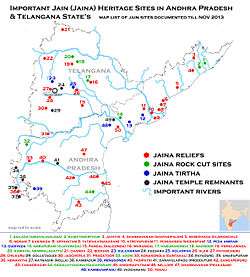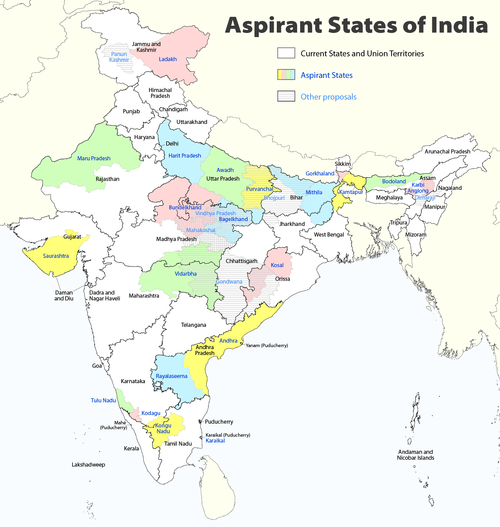Rayalaseema
| Rayalaseema రాయలసీమ | |
|---|---|
| Region of Andhra Pradesh | |
 Rayalaseema in Andhra Pradesh | |
| Country | India |
| State | Andhra Pradesh |
| Area[1] | |
| • Total | 67,526 km2 (26,072 sq mi) |
| Population (2011) | |
| • Total | 15,184,908 |
| • Density | 226/km2 (590/sq mi) |
| Languages | |
| • Official | Telugu, Urdu |
| Time zone | IST (UTC+05:30) |
| Largest city |
Kurnool (by population)) Kadapa (by area) |
Rayalaseema (Rāyalasīma) is a geographic region in the Indian state of Andhra Pradesh. It includes the four southern districts of Anantapur, Chittoor, Kadapa and Kurnool.[2] As of 2011 census of India, the region with four districts has a total population of 15,184,908 and covers an area of 67,526 km2 (26,072 sq mi).[3]
The region borders the state of Tamil Nadu to the south, Karnataka to the west and Telangana to the north.[4]
History
During the British era, the Nizam of Hyderabad ceded this area to the British, and hence was called Ceded Districts'. Independence, it was renamed as Rayalaseema as 'seema' was an administrative unit of the Vijayanagara Empire similar to today's districts.
Post independence
The four districts of the region were part of the Madras Presidency until 1953.[5] From 1953–1956, the region was a part of Andhra State and in 1956, the Telangana region was merged with Andhra State to form Andhra Pradesh State.[6] On 2 February 1970, three taluks from Kurnool i.e, Markapur, Cumbum and Giddalur were merged along with some other taluks of Nellore district and Guntur district to form Prakasam district.
According to research reports, a high-level meeting of Andhra leaders under the banner Andhra Mahasabha and Andhra Provincial Conference or Ceded Districts Conference was held at Nandyal on November 17 and 18 of 1928 where the issue figured and debated extensively among other things.
Chilukuri Narayana Rao, a Telugu lecturer and activist from Anantapur, moved the resolution saying that the term “ceded” was derogatory and amounted to slavery and hence the region comprising Bellary, Anantapur, Chittoor, Cadapah and Kurnool be referred to as “Rayalaseema”.
The proposal was seconded by stalwarts like Sarvepalli Radhakrishnan, Gadicharla Harisarvotha Rao, Kadapa Koti Reddy, Kalluri Subba Rao and Pappuri Ramacharyulu. Luminaries like Annie Besant, Prakasam Panthulu, Kasinathuni Nageswara Rao, C. Doraiswamy Iyengar, Konda Venkatappaiah, Duvvuri Subbamma and others were also present at the historic meeting.
In February 2014, the Andhra Pradesh Reorganisation Act, 2014 bill was passed by the Parliament of India for the formation of Telangana state comprising ten districts. Hyderabad will remain as a joint capital for 10 years for both Andhra Pradesh and Telangana.[7] The new state of Telangana came into existence on 2 June 2014 after approval from the President of India.[8] The formation of a new state named Telangana from Andhra Pradesh is not considered an amendment to the Constitution of India per article 3 and 4 of that document.[9]
Major cities and towns are Kurnool, Kadapa, Anantapur, Tirupathi and Chittoor are the major cities of the region.
Geography
Rayalaseema region is located in the southern region of the state of Andhra Pradesh.
Etymology
Nizam of Hyderabad ceded the districts of this region to Britishers and hence, they were referred as Ceded districts. In 1928, a strong dislike was expressed from the leaders in the Andhra Mahasabha, held at Nandyal. The region got its name as Rayalaseema with a proposal from Chilukuri Narayana Rao and was accepted.
Economy
Rayalaseema is rich in minerals - Asbestos, Barytes, China clay, Calcite, Dolomite, Diamonds, Green Quartz, Iron ore, Lime stone and Silica sand. It also has rich forest wealth like the rare Red sandalwood which is highly economical, and main revenue source for the state, and other forest sources include non timber resources, medicinal plants etc. The region has the TTD board, the richest religious board in the country.
The Rayalaseema area is prone to drought. In 2015, locals complained about a neglect of several projects to alleviate this, particularly in the areas of irrigation.[10]
Culture


Literature
Telugu culture reached its zenith during the Vijayanagara rule under Sri Krishnadevaraya. Amongst Ashta Diggajas, Allasani Peddana, Dhoorjati, Nandi Timmana, Maadayyagari Mallana and Ayyalaraju RamaBhadrudu are from this region. Poets like Vemana, Sri Potuluri Virabrahmendra Swami from Kadapa district played a great role in educating the common people through their literary works. It is also written by most experts (per Kandukuri Viresalingam etc) until 1930s that Pothana, who penned Andhra Mahabhagavatham, actually belonged to Ontimitta village of Kadapa District. Indian philosopher and spiritual teacher Jiddu Krishnamurti and Cattamanchi Ramalinga Reddy - an essayist, poet and educationist are from this region. Yogi Vemana is also a notable poet.
Music and actors
There are many notable actors in film industry such as, Chitturu Nagayya, Kadiri Venkata Reddy, Pasupuleti Kannamba, Basavaraju Venkata Padmanabha Rao, Chadalavada Kutumba Rao etc. Musicians and poets include, Annamayya, Rallapalli Anantha Krishna Sharma, Vellaala Subbamma etc.
Annamayya is a spiritual guru, who wrote songs on Lord Venkateswara, Sri Potuluri Virabrahmendra Swami, Ganapathi Sachchidananda, Satya Sai baba is a spiritual and religious savant, Jiddu Krishnamurtie.
Landmarks

Gandikota is one of the oldest fort dating back to 1123. Belum Caves are the second largest cave in Indian sub-continent and the longest caves in plains of Indian Subcontinent. It is located at Belum Village of Kurnool District. Sri Lankamalleswara Wildlife Sanctuary is the only Sanctuary in the world which provides home for a bird called Jerdon's courser. Gurramkonda, Chandragiri, Horsley Hills, Kuppam and Talakona of Chittoor district.
Thimmama Marrimanu, world's largest banyan tree, covering 5.2 acres (21,000 m2) and 550 years old. It holds a Guinness record. It is situated Near Kadiri, 120 kilometres from Anantapur.
Religious destinations
Rayalaseema has many important places of pilgrimage. Tirumala Venkateswara Temple, abode of Lord Venkateswara is the richest and the most visited place of worship in the world. The other being Tiruchanuru, Srisailam, Ahobilam, Srikalahasti, Kanipakam, Kadiri, Rayadurgam, Penna Ahobilam, Karvetinagaram, Mahanandi, Mantralayam, Puttaparthi, Yaganti, Lepakshi, Ontimitta, Bramhamgarimatham etc. Shahi jamia masjid in Adoni is one of the oldest construction in South India, built around 1662 AD by Siddi Masood Khan,[11] Ameen Peer Dargah, a famous Sufi Shrine in India.
Education
JNTU is the top university in Rayalaseema region, some of the best engineering colleges in Rayalseema include SVNE located 15 km away from Tirupati, RGMCET located at Nandyal, G Pulla reddy located at Kurnool. SV University is located in Tirupati which is considered to be a hub for education in Rayalaseema. Rayalaseema universities include, Sri Venkateswara University, Sri Padmavati Mahila Visvavidyalayam, IIT Tirupati, IISER, Sri Sathya Sai University, Sri Krishnadevaraya University, JNTU Anantapur, Yogi Vemana University, Rayalaseema University, Kurnool Medical College, Indian Institute of Information Technology, Dravidian University, Potti Sreeramulu Telugu University
Politics

Neelam Sanjiva Reddy, Damodaram Sanjivayya, Kotla Vijaya Bhaskara Reddy, N. Chandrababu Naidu, Y. S. Rajasekhara Reddy and N.Kiran Kumar Reddy are the people who served as Chief Minister of Andhra Pradesh, hail from the Rayalaseema region of the state, with N. Chandrababu Naidu being the incumbent. The region saw as many as 6 chief ministers for the state.[12]
Sri Baghpact
Based on Sri Bagh Pact signed on 15 November 1937, Kurnool was made as the capital of the new state after the division of Andhra state from the Madras state.[13][14] As per the second State Resolution Commission, capital was shifted to Hyderabad upon the formation of Andhra Pradesh.[15]
See also
References
- ↑ "Andhra Pradesh Fact Sheet". mapsofindia.com.
- ↑ Rajeev, M (11 October 2015). "Rayalaseema in a state of discontent". The Hindu. Archived from the original on 8 December 2015. Retrieved 8 December 2015.
- ↑ "Population of AP districts(2011)" (pdf). ap.gov.in. p. 14. Retrieved 25 May 2014.
- ↑ "Andhra Pradesh - end of an era". Business Standard. Hyderabad. 30 July 2013. Retrieved 8 April 2016.
- ↑ "The Indian Express - Google News Archive Search". google.com.
- ↑ "The Indian Express - Google News Archive Search". google.com.
- ↑ "The Andhra Pradesh Reorganisation Act, 2014" (PDF). India Code Legislative Department. Ministry of Law and Justice. 1 March 2014. p. 2. Retrieved 14 July 2015.
- ↑ "Telangana state formation gazette". The New Indian Express. Retrieved 14 May 2014.
- ↑ "Constitution of India Sub-section". 4 March 2014. Retrieved 23 April 2014.
- ↑ http://www.thehindu.com/news/national/state-view-rayalaseema-in-a-state-of-discontent/article7747573.ece
- ↑ http://www.indiahotelreview.com/travel-guide/mantralayam/getaways-around-mantralyam-adoni-91-598.htm
- ↑ "Telangana.com - Committed For Development Telangana......". telangana.com.
- ↑ Raju, P. Yenadi (2003). Rayalaseema during colonial times : a study un indian nationalism. New Dehli: Northern Book Centre. p. 214. ISBN 978-81-7211-139-7. Retrieved 3 September 2015.
- ↑ "APonline - History and Culture - History-Post-Independence Era". aponline.gov.in.
- ↑ "Revive Sri Bagh pact, demands vedika". Hyderabad. 19 June 2014. Retrieved 3 September 2015.
External links
![]() Media related to Rayalaseema at Wikimedia Commons
Media related to Rayalaseema at Wikimedia Commons
